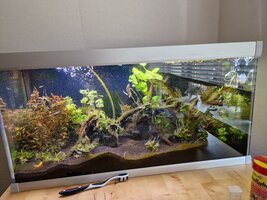Hi guys.
So, 5 weeks ago I started an 80 Liter aquarium, using Tropica Soil as substrate. I then got the expected Ammonia spike first, then a Nitrite spike. After 4 weeks it had tested free from Ammonia several weeks and free from Nitrite for a few days, so I added the first fish. Two young (not adult size) Lyretail Killi. Everything went by the book and the fish acted normal and healthy. Then today, four days later, since the two Killi were still apparently healthy and happy, I did a big water change, stupidly not testing the water since the fish didn't indicate anything wrong, then added 12 Microdevario kubotai, after acclimatising them carefully (drip). To my surprise the new fish seemed very lethargic, not handling the current in the water and most of them hiding. So I tested the water again and to my horror it showed Nitrite! 0.3 mg/L, so not dramatic amounts, but still. So now I'm apparently cycling an aquarium with fish in it! I immediately did a big (about 70%) water change of course. But now what? How much water do I change and how frequently until the tank is done cycling and handling the number of fish?
The tank is pretty densely planted (including floating plants), but has an algae problem (diatom), which I figure is normal in such a new tank.
Thanks for any advice!
So, 5 weeks ago I started an 80 Liter aquarium, using Tropica Soil as substrate. I then got the expected Ammonia spike first, then a Nitrite spike. After 4 weeks it had tested free from Ammonia several weeks and free from Nitrite for a few days, so I added the first fish. Two young (not adult size) Lyretail Killi. Everything went by the book and the fish acted normal and healthy. Then today, four days later, since the two Killi were still apparently healthy and happy, I did a big water change, stupidly not testing the water since the fish didn't indicate anything wrong, then added 12 Microdevario kubotai, after acclimatising them carefully (drip). To my surprise the new fish seemed very lethargic, not handling the current in the water and most of them hiding. So I tested the water again and to my horror it showed Nitrite! 0.3 mg/L, so not dramatic amounts, but still. So now I'm apparently cycling an aquarium with fish in it! I immediately did a big (about 70%) water change of course. But now what? How much water do I change and how frequently until the tank is done cycling and handling the number of fish?
The tank is pretty densely planted (including floating plants), but has an algae problem (diatom), which I figure is normal in such a new tank.
Thanks for any advice!



